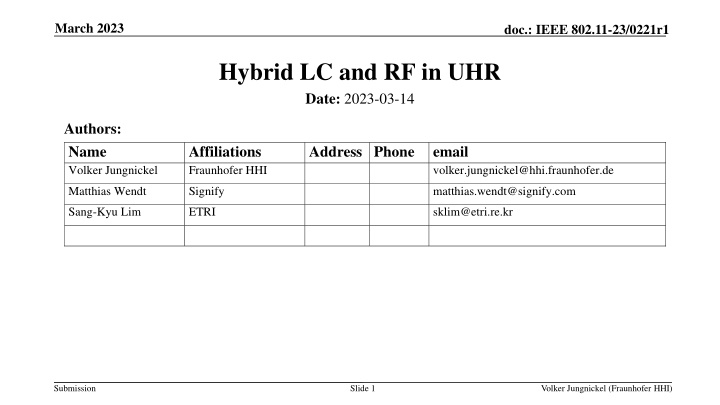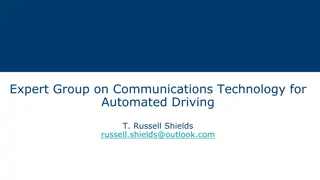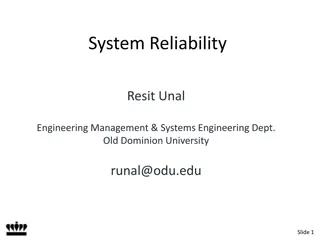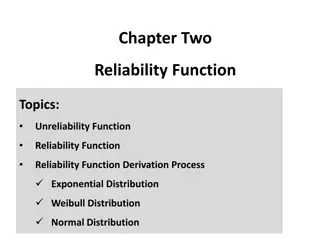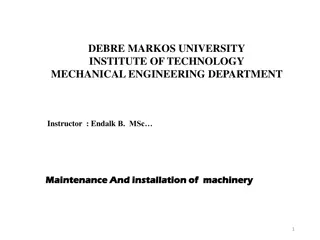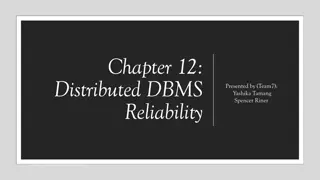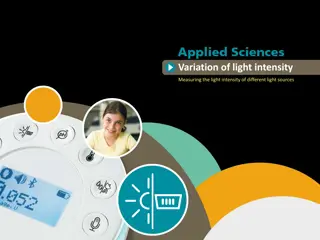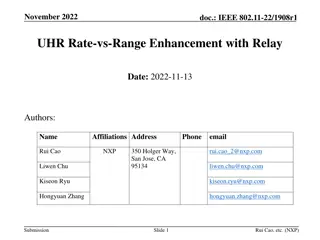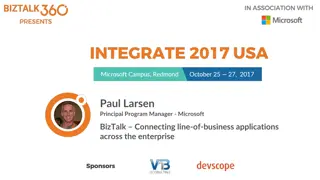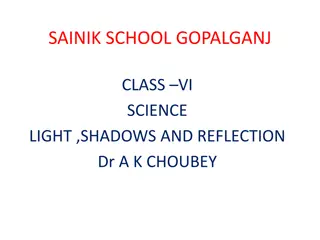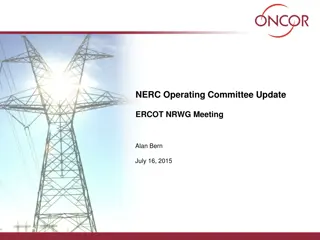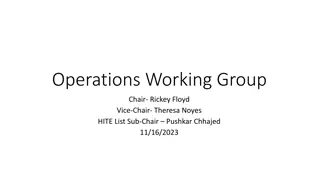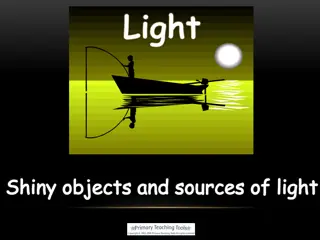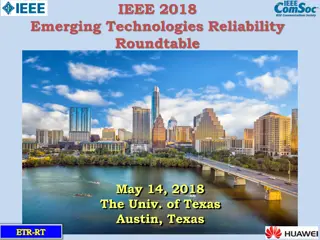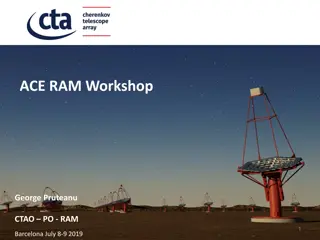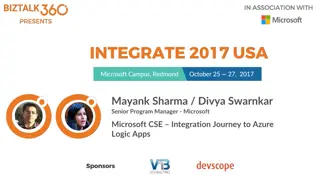Integration of Light Communications for Enhanced Reliability in Multilink Operations
The presentation discusses the integration of Light Communications (LC) into the Multilink Operation (MLO) framework to enhance reliability and reduce latency in wireless communications. By proposing the incorporation of LC as a new offloading opportunity within the MLO framework, the potential for improved reliability and low latency in critical scenarios is highlighted. The focus is on developing an open interface for LC in the MLO framework, allowing for the seamless integration of LC with RF bands. The challenges of offloading, including bandwidth limitations and the need for additional capacity for reliability and latency guarantees, are also addressed.
Download Presentation

Please find below an Image/Link to download the presentation.
The content on the website is provided AS IS for your information and personal use only. It may not be sold, licensed, or shared on other websites without obtaining consent from the author.If you encounter any issues during the download, it is possible that the publisher has removed the file from their server.
You are allowed to download the files provided on this website for personal or commercial use, subject to the condition that they are used lawfully. All files are the property of their respective owners.
The content on the website is provided AS IS for your information and personal use only. It may not be sold, licensed, or shared on other websites without obtaining consent from the author.
E N D
Presentation Transcript
March 2023 doc.: IEEE 802.11-23/0221r1 Hybrid LC and RF in UHR Date: 2023-03-14 Authors: Name Volker Jungnickel Affiliations Fraunhofer HHI Address Phone email volker.jungnickel@hhi.fraunhofer.de Matthias Wendt Signify matthias.wendt@signify.com Sang-Kyu Lim ETRI sklim@etri.re.kr Submission Slide 1 Volker Jungnickel (Fraunhofer HHI)
March 2023 doc.: IEEE 802.11-23/0221r1 Outline Introduction Multilink operation Light communications Analysis of 11be and 11bb PARs Summary References Straw poll Submission Slide 2 Volker Jungnickel (Fraunhofer HHI)
March 2023 doc.: IEEE 802.11-23/0221r1 Introduction Multilink operation (MLO) allows parallel operation over 2.4, 5 and 6 GHz bands. This contribution proposes integration of Light Communications (LC) into the MLO framework, as a new offloading opportunity to improve reliability. LC enables high reliability and low latency in critical scenarios where RF may be congested. 802.11be and 802.11bb PARs limited the scope to RF bands at 2.4, 5 and 6 GHz and optical bands in 800 nm to 1000 nm range, respectively. This presentation proposes developing an open interface for LC in the MLO framework in UHR, which enables the integration of LC with RF. Submission Slide 3 Volker Jungnickel (Fraunhofer HHI)
March 2023 doc.: IEEE 802.11-23/0221r1 Multilink Operation [1] Multilink operation (MLO) allows parallel operation over 2.4, 5 and 6 GHz bands. The MAC is split into MLD upper MACs, MLD lower MACs and Link 1/Link 2. Submission Slide 4 Volker Jungnickel (Fraunhofer HHI)
March 2023 doc.: IEEE 802.11-23/0221r1 Offloading: Enhanced reliability and lower latency Each RF band has independent channel access CCA is done on all bands operated in parallel If the link is busy in current band, another band can be used Offloading enhances reliability and reduces latency In dense traffic, however, capacity of all bands may be exhausted MLO can find no more free bandwidth More bandwidth is required for reliability and latency guaranties Submission Slide 5 Volker Jungnickel (Fraunhofer HHI)
March 2023 doc.: IEEE 802.11-23/0221r1 LC provides a deterministic channel In contrast to MLO over RF, MLO over LC can be deterministic UHR demands cable-like QoS over wireless links applications want to get rid of cables and use similar properties no packet loss, lower latency, zero jitter for TSN support This is a challenge in randomly shared radio spectrum RF going through walls makes interference unpredictable 1. Interference from other technologies (Bluetooth, ZigBee, UWB) 2. Interference from other APs MLO forms compound channel based on multiple loose contacts Parallel circuit improves the situation in low-to-moderate load But MLO does not provide guaranteed delivery in dense traffic scenarios Submission Slide 6 Volker Jungnickel (Fraunhofer HHI)
March 2023 doc.: IEEE 802.11-23/0221r1 What is Light Communication? Unique Selling Points: Higher capacity/area in small hotspots 1 10 Mbps/m (RF) vs. 100+ Mbps/m (LC) Cable-like QoS: Guaranteed delivery in dense traffic Robust against jamming, enhanced privacy Key facts: Mobile communication by using light Mobile, bidirectional, high-speed Useful complement to RF Complement RF by LC RF is already mature and established in the market LC adds new value to RF Important synergies, both indoors and outdoors RF systems can take new opportunities by adding LC Submission Slide 7 Volker Jungnickel (Fraunhofer HHI)
March 2023 doc.: IEEE 802.11-23/0221r1 Opportunities Light Communication is fundamentally more reliable than RF Coexistence with other radio technologies is not an issue because LC does not interfere with RF Interference from other APs is not an issue because LC does not pass through walls LC can be used together with deterministic channel access Submission Slide 8 Volker Jungnickel (Fraunhofer HHI)
March 2023 doc.: IEEE 802.11-23/0221r1 Hybrid LC and RF Parallel operation of LC and RF [4] spotty optical vs. ubiquitous radio coverage in industrial use cases +Synergies: offloading, robustness against rain and fog antenna connector antenna connector LC optical TX antenna LC optical RX antenna MIMO using LC optical and RF antennas [5] 802.11bb is based on random channel access CCA on one link could block the other link, too LC PHY RX Data out LC PHY TX Data in RF Tx antenna RF RX antenna Better combine LC and RF using MLO framework developed by 802.11be Submission Slide 9 Volker Jungnickel (Fraunhofer HHI)
March 2023 doc.: IEEE 802.11-23/0221r1 Analysis of 11be and 11bb PARs 802.11be PAR limits carrier frequency operation between 1 and 7.250 GHz 802.11bb limits operations to 800 nm to 1000 nm band Both projects are in final phase, thus PAR ammendments are not feasible Existing PARs unfortunately exclude hybrid operation of RF and LC hybrid LC and RF can only be enabled by a future project this will impact the mainstream, and maybe easily done in UHR Submission Slide 10 Volker Jungnickel (Fraunhofer HHI)
March 2023 doc.: IEEE 802.11-23/0221r1 LC in MLO via Small Enhancement of agreed Architecture Separation of MAC in Upper and Lower MLD part already exists Integration of future technologies kincluding LC would benefit from an open interface between the two Enables the operation of LC as a new wireless medium next to 2.4, 5 and 6 GHz. Open Interface for LC Submission Slide 11 Volker Jungnickel (Fraunhofer HHI)
March 2023 doc.: IEEE 802.11-23/0221r1 Summary Offloading needs to integrate further bands integrate LC PHY, possibly together with a deterministic channel access mechanism this would substantially improve reliability, reduce latency/jitter and increase throughput IEEE P802.11bb discussed hybrid operation of LC and RF previous proposal in 11bb had a severe technical issue it was suggested to integrate LC into 802.11 using the MLO framework in 802.11be this was, however, out of scope for both, TGbb and TGbe Develop an open interface for LC in UHR further develop MLD lower MAC and MLD PHY for LC in a separate project Submission Slide 12 Volker Jungnickel (Fraunhofer HHI)
March 2023 doc.: IEEE 802.11-23/0221r1 References [1] IEEE P802.11be /D3.0: Draft Standard for Information technology Tele-communications and information exchange betw. systems Local and metropolitan area networks Specific requirements Part 11: Wireless LAN Medium Access Control (MAC) and Physical Layer (PHY) Specifications Amendment 8: Enhancements for extremely high throughput (EHT) [2] V. Jungnickel et al., Light Communication for UHR , https://mentor.ieee.org/802.11/dcn/23/11-23-0091- 00-0wng-light-communication-for-uhr.pptx [3] Tutorial#1 on IEEE 802 Standards on Light Communication in March 2023 meeting https://mentor.ieee.org/802.11/dcn/23/11-23-0277-01-0000-ieee-802-standards-on-light- communication.pdf [4] M. Ayyash et al., "Coexistence of WiFi and LiFi toward 5G: concepts, opportunities, and challenges," in IEEE Communications Magazine, vol. 54, no. 2, pp. 64-71, February 2016 [5] V. Jungnickel et al. LC/RF multiplexing , https://mentor.ieee.org/802.11/dcn/23/11-23-0006-00-00bb-lc- rf-multiplexing.docx Submission Slide 13 Volker Jungnickel (Fraunhofer HHI)
March 2023 doc.: IEEE 802.11-23/0221r1 Straw Poll Would you support that a) UHR integrates LC into the Multilink Operations framework? b) A New Study Group is formed to integrate LC and RF using MLO? c) Abstain. Submission Slide 14 Volker Jungnickel (Fraunhofer HHI)
March 2023 doc.: IEEE 802.11-23/0221r1 Analysis of 11be and 11bb PARs 802.11be 5.2.b Scope of the project: This amendment defines standardized modifications to both the IEEE Std 802.11 physical layers (PHY) and the Medium Access Control Layer (MAC) that enable at least one mode of operation capable of supporting a maximum throughput of at least 30 Gbps, as measured at the MAC data service access point (SAP), with carrier frequency operation between 1 and 7.250 GHz while ensuring backward compatibility and coexistence with legacy IEEE Std 802.11 compliant devices operating in the 2.4 GHz, 5 GHz, and 6 GHz bands. This amendment defines at least one mode of operation capable of improved worst case latency and jitter. 802.11bb 5.2.b Scope of the project: This amendment specifies a new PHY layer and modifications to the IEEE 802.11 MAC that enable operation of wireless light communications (LC). This amendment specifies a PHY that provides: 1) Uplink and downlink operations in 800 nm to 1000 nm band, 2) All modes of operation achieve minimum single-link throughput of 10 Mb/s as measured at the MAC data service access point (SAP), 3) Interoperability among solid state light sources with different modulation bandwidths. This amendment specifies changes to the IEEE 802.11 MAC that are limited to the following: 1) Hybrid coordination function (HCF) channel access, 2) Overlapping basic service set (OBSS) detection and coexistence, 3) Existing power management modes of operation (excluding new modes), and modifications to other clauses necessary to support these changes. Existing PARs unfortunately exclude hybrid operation of RF and LC hybrid LC and RF can only be enabled by a future project this will impact the mainstream, and maybe easily done in UHR Submission Slide 15 Volker Jungnickel (Fraunhofer HHI)
